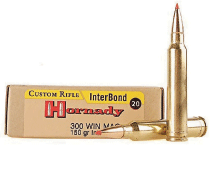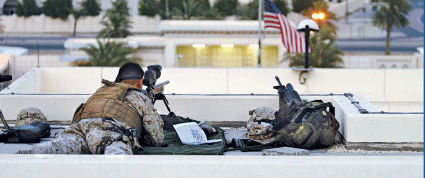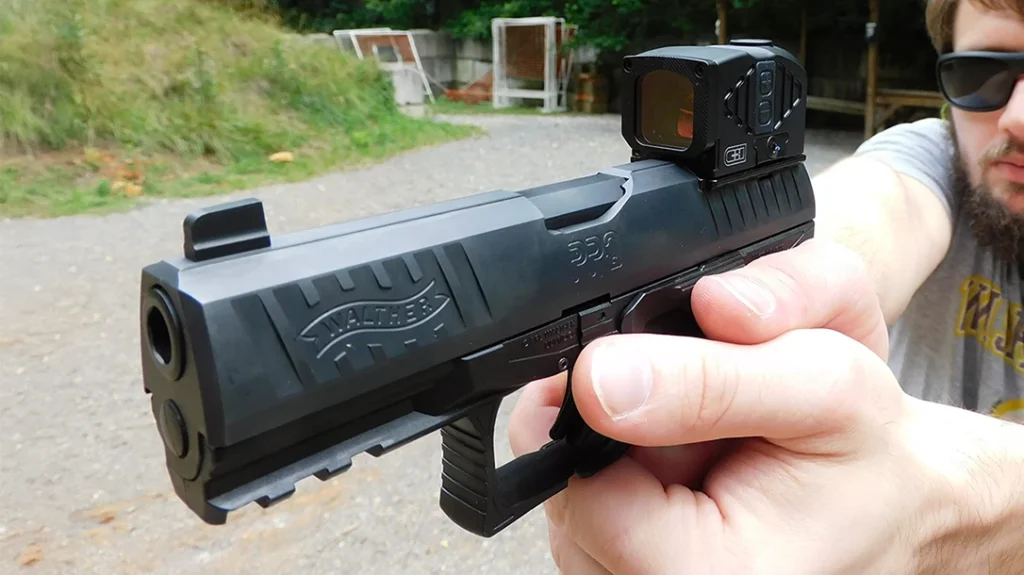In the field of tactical precision rifle cartridges, there are a number of contenders for top gun and they are formidable indeed. Beginning with the .308 (7.62x51mm NATO) and continuing through the .30-06, .30-338 and .300 Weatherby to the mighty .338 Lapua, there exist about a dozen various cartridges capable of exceptional accuracy and long-range performance.
 Without a doubt, the .308 is the most popular, mostly because of its use by the US military as a sniper cartridge for the last 40 or so years. However, though it’s well understood, highly accurate and produces minimal recoil, it lacks the capability for truly efficient performance past 600 meters.
Without a doubt, the .308 is the most popular, mostly because of its use by the US military as a sniper cartridge for the last 40 or so years. However, though it’s well understood, highly accurate and produces minimal recoil, it lacks the capability for truly efficient performance past 600 meters.
The famous .30-06 is a superb cartridge and is so versatile that it is often considered to be the “universal cartridge.” However, though its case capacity is greater than the .308, allowing it to hit noticeably harder at ranges past 200 meters, it still isn’t an especially high-performance cartridge, particularly with the 168- to 200-grain bullet weights usually associated with long-range or precision shooting.
Advertisement — Continue Reading Below
Its detractors often claim that it’s not as accurate as the .308 (which was designed to duplicate its .30 M2 150-grain military loading), but I’ve found this to be untrue. In identical custom precision rifles I’ve tested over the years, the .30-06, even without match ammo, consistently exhibited superior accuracy at all ranges. Nonetheless, while with carefully developed loads, it can drive 168-grain bullets at 2900 fps (feet per second) with excellent accuracy from a 24-inch barrel, a magnum-class cartridge it is not!
Magnum Cartridges
On the other end of the spectrum, we have the relative new .338 Lapua. With its heavier, larger caliber bullet, driven at velocities in the 3000 fps range, it has gained significant popularity, particularly within the European military community.
Its problem is excessive recoil. In nearly every instance, in order to keep its considerable recoil under control, exceptionally heavy rifles, such as those from Accuracy International, are required. Weapons are unquestionably accurate, but are so large and heavy that they’re virtually useless unless shot from a rest or integral bipod, which is not always possible in the field. As well, these same characteristics prevent their use in a more traditional role, should the shooter be forced to fight his way clear during departure from the target area.
Advertisement — Continue Reading Below
This leaves the .30-338, .300Win Mag and .300 Weatherby, all of which have a long and deserved reputation for excellence. The .300 Weatherby first appeared in 1944 and was Roy Weatherby’s first high-performance cartridge. Since then, it has enjoyed a loyal following of both sportsmen and precision rifle shooters alike and with good reason. With its long, high-capacity venturi-shouldered case, it can drive bullets of 180- to 200-grains at velocities over 3000 fps with ease.
However, it does produce considerable recoil, which is considered by many to be intolerable if one must get down behind the rifle and shoot 40 to 50 shots in a session. While this particular criticism is somewhat overstated, its basis is essentially sound. The .300 Weatherby is a hot number and does produce serious recoil, requiring a relatively heavy rifle to control and prevent shooter abuse.
.30-338
First appearing back in the late 1950s, the .30-338 is perhaps the most efficient of the .30 caliber magnum-class cartridges and is also highly popular, particularly among long-range high-power competition shooters, which is
why it was created in the first place.
Advertisement — Continue Reading Below
Being based upon the legendary .338Win Mag, its case is highly efficient and considerably shorter than traditional .30 caliber magnums, thus offering a number of advantages. First of all, it produces virtually the same ballistics, but with about 10 grains less powder. Second, it offers more flexibility in bullet seating depths than the longer .300 Mags. Third, it enjoys a justifiable reputation for exceptional intrinsic accuracy.
Still, the .30-338 is a hot .300 magnum-class cartridge and does therefore generate serious recoil, requiring a fairly heavy rifle to control. It’s major drawback is that while it has on several occasions been considered for factory production by major ammo manufacturers, it remains a wildcat cartridge, requiring custom loading to produce. For many, this alone disqualifies it from further consideration.
So, when compared to one another, the .300 Weatherby, .30-338 and .338 Lapua all exhibit the same fundamental characteristics with the minor exception that the .30-338 is noticeably more accurate than the other two. However, to keep a realistic perspective, it must also be said that with thoughtful loading, all of them are capable of exceptional accuracy, accuracy that is beyond the marksmanship ability of even the most expert operator.
Advertisement — Continue Reading Below
.300Win Mag
And this brings us to the .300Win Mag. First offered more than 40 years ago, its popularity has continued to grow and not without good reason. With a case capacity far greater than either the .308 or .30-06, it rivals the .300 Weatherby in performance, differing only in the fact that it utilizes a more traditional shoulder design and its neck is a bit shorter.
As well, as opposed to the other magnum class .30 caliber cartridges, it’s offered by all of the major ammo manufacturers in a wide variety of bullet weights and loadings. This single characteristic makes the .300Win the dominant cartridge of its class.
Typically, for long-range competition or tactical purposes, factory-loaded .300Win Mag ammunition most often utilizes a 180- or 190-grain bullet, driven at 2850 to 2950 fps. However, with a 150- to 165-grain expanding bullet, it’s capable of 3,000+ fps velocities, equal accuracy with noticeably less recoil, a flatter trajectory out to 750 meters or so and excellent terminal ballistics on living targets.
Advertisement — Continue Reading Below
Those that prefer target-type BTHP bullets have a good spectrum of factory loads from which to choose. Black Hills and Remington dominate this arena, both offering excellent 190-grain BTHP match loads for a reasonable price.
Range Time
In my test rifle, a full-house custom Remington M700 with a Leupold 3.5-10x50mm tactical scope, both consistently shot 100-meter, 3-shot groups of less than 1/2-MOA.
Still, if all other things are equal, why not use an expanding bullet? Personally, I prefer this option, since nothing is being sacrificed in order to achieve it. All that’s required is a careful evaluation of available loadings to determine which one performs best in our particular rifle, a process that would also be required with BTHP match loads as well. And the superior terminal ballistics produced by expanding bullets make a huge difference, particularly at longer ranges.
Advertisement — Continue Reading Below
In my test rifle, factory 150-grain loadings with expanding bullets shot exceptionally well, though they represent those that shot best in my test rifle. And while the heavier bullets do range slightly better past 750 meters than the 150- to 165-grain types, the difference is so small that it’s unnoticeable because it’s well within a given shooter’s error margins at those distances.
What’s more important is that lighter bullets produce less recoil, allowing a lighter-weight rifle to be used. Lighter weight, in turn, translates to easier field carry and less shooter fatigue. This factor, along with the virtually equal performance and less recoil of a properly selected 150-grain bullet, is why I personally prefer the lighter bullet.
The performance also discloses another reason for the .300Win Mag’s popularity, its versatility. As such, it appeals to almost everyone who prefers a more potent cartridge than the traditional .308 or .30-06, but without the shoulder-numbing recoil produced by many of the big magnums.
Advertisement — Continue Reading Below
Final Notes
Without a doubt, it isn’t for everyone, but with careful mission-definition and subsequent ammunition selection, it will perform nicely in a tremendously wide variety of tactical circumstances. It’s highly accurate, powerful and can do things not possible with either the .308Win or .30-06. Thus, it’s an especially good choice if rural as well as urban and suburban missions are involved.
Check out our article about the .30-30 Winchester – History & Ballistics
Advertisement — Continue Reading Below
























